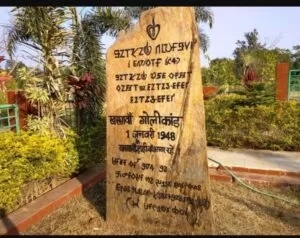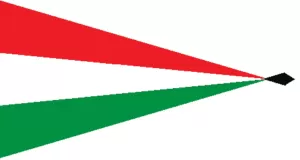सरायकेला खरसावां देशी रियासत
Saraikela Kharsawan Princely State
At the time of independence, there were more than 560 princely states in India. Among these princely states, there were only two princely states in undivided Bihar:- Saraikela princely state and Kharsawan princely state. The British East India Company never had direct suzerainty in these princely states. The relations of the princely state of Saraikela and Kharsawan were always good with the British. Because of this, in 1899, both these princely states were approved by the British as the princely states. In 1899, both SaraikelaKharsawan became the Karad state of British rule. Separate court, police stations and Police were arranged for these two states. For the state of Seraikela, police stations were set up at Saraikela and Govindpur, while for Kharsawan state, police stations were set up at Kharsawan and Kuchai. Both these princely states had to be under the supervision of the Principal Assistant of Chaibasa. In 1934, both these princely states were placed under the supervision of the Eastern States Agency. Both these princely states joined the Indian Union on 1 January 1948.
Kharsawan Golikand
At that time it was made a part of Mayurbhanj district of Orissa state. In protest against which the people here organized a protest at Kharsawan Haat ground on 1 January 1948. Jaipal Singh Munda was about to attend this meeting, but due to security reasons, he could not attend the meeting, due to which the crowd became furious and the Orissa Military Police had to open fire, due to which many people died.This event is known as “Kharsawan-Golikand” in the history of Jharkhand. Socialist leader Ram Manohar Lohia named this incident as “Azad Bharat’s Jallianwala massacre”. Due to the fierce opposition of the people, on 18 May 1948, Saraikela and Kharsawan were temporarily included in Singhbhum district of Bihar. Seraikela and Kharsawan remained under the state of Orissa for a total of 139 days. In 1956, through a government notification, Saraikela & Kharsawan were declared as a permanent part of undived Bihar.

Note:- The Eastern States Agency was established in 1934, which looked after all the 24 princely states located in the province of Orissa. It was abolished by the Government of India on 1 January 1948.
Saraikela princely state
King of Singh dynasty, Jagannath Singh had 2 sons, Purushottam Singh and Vikram Singh. Purushottam Singh died soon after the marriage. His wife was pregnant. Three months after the death of Purushottam Singh, his son Arjun Singh was born. In this way, due to the two descendants of Jagannath Singh, the Singh dynasty was divided and the state of Porhat was divided into two. Vikram Singh was given an area of 76 square kilometer which had 12 villages. And Arjun Singh, son of Purushottam Singh, was made the king of Porhat, now this state came to be known as Porhat Peed.

The princely state of Saraikela was established in 1620 AD by Vikram Singh I (1620-1677), son of Singhvanshi Jagannath Singh. He assumed the title of Kunwar, leaving his traditional title, Singhdev. His descendants held this title till 1884, after which he adopted the title of Raja. This princely state was spread over 700 square kilometers. Initially Vikram Singh was assigned an area of 76 km between the Sanjay and Kharkai rivers, with only 12 villages under it. Vikram Singh was very ambitious and war minded. He conquered many surrounding areas like Dungi, Kandra, Kharsawan, Asantali, Patkom, Baksai, Gamharia, Ichhagarh and has covered 700 sq km of Seraikela area. To its north was Manbhum district Kharsawan and Kolhan Government State in the west, Mayurbhanj State in the south and Dhalbhum in the east. On 18 May 1948, Aditya Pratap Singh Deo, the last king of the princely state of Seraikela, signed a Memorandum of Understanding on the accession of India. In 1939, King Aditya Dev had done a lot of reforms in his kingdom.
Saraikela/Kharsawan state during 1857 rebellion
-During the revolt of 1857 AD, when the sepoys revolted in Chaibasa Cantonment, at that time the commander Shishmore handed over the responsibility of Chaibasa Cantonment to Raja Jagannath Singh of Saraikela princely state.The Sanjay river was in spate when the rebels decided to go to Ranchi. The rebels did not reach Ranchi, so Raja Jagannath Singh of Seraikela and Raja Hari Singh of Kharsawan blocked their way on the banks of river Sanjay. At that time, King Arjun Singh of Porhat had sent his general Jaggu Diwan to help the rebels. In this rebellion, to support Jagannath Singh with the British, Karaikela was brought under the princely state of Saraikela.
Saraikela state during 1857 rebellion
Status of Saraikela Legacy during Tamad Rebellion At this time the Raja of Saraikela princely state was Kunwar Vikram Singh-II. In 1820, the revolutionary leader of the Tamad rebellion, Rudan Singh took refuge in the princely state of Saraikela, but Kunwar Vikram Singh captured it and handed it over to the British.
Kharsawan Princely State
The princely state of Kharsawan was established in 1650 AD by Padma Singh, the second son of Vikram Singh.Kharsawan state was spread over an area of 225 square kilometres. In the north of this state, Ranchi was situated in the east, Seraikela princely state, in the south the Kolhan Government State was situated. Vikram Singh had 3 sons.The eldest son Narusingh Kunwar extended the princely state of Seraikela. At the same time, his second son laid the foundation of the princely state of Kharsawan in 1650 and his third son Kishan Singh created the princely state of Asantali. In the absence of a successor in the Asantali princely state, in 1770, Padam Singh was annexed to his kingdom. Padam Singh had assumed the title of “Thakur”, which was also held by his descendants for a long time.

Note:- Both these princely states sided with the British at the time of revolt of 1857 and during the capture of Kolhan in 1837.
Saraikela Kharsawan Princely State


